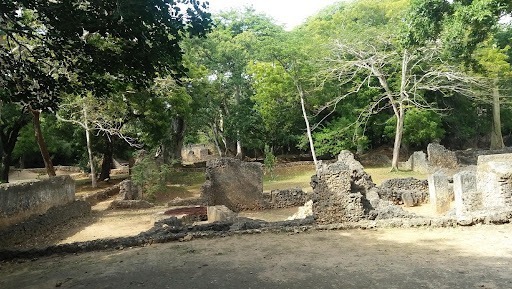Kenya, a country in the Eastern part of Africa, is not only known for its beautiful cities and infrastructure but also widely known for its breathtaking landscapes, abundant wildlife, and vibrant culture.
However, beyond the rolling savannahs and sun-kissed beaches lies a country steeped in culture and resilience, with historical landmarks in Kenya. The historical places in Kenya tell stories of ancient civilizations, colonial struggles, freedom fighters, and long-standing trade networks that shaped not only the nation but also influenced the wider East African region.
Naicef gives you a chance to explore these prehistoric sites in Kenya and get to step into their stories as you enjoy their journey through time.
For a curated tour to historic sites in Nairobi Kenya, or any other historic sites in Kenya and their location, reach out to Naicef via our contact email at my@naicef.com or tap: +254799922277.
Also, you can choose to;
Book The Tour Here
Today, in this article, you will get to explore some of the most significant and fascinating historical places in Kenya. Each one shows a part of the country’s rich and varied history.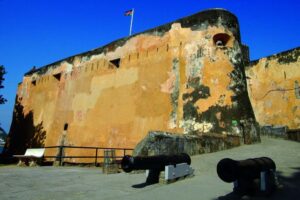
Interesting Facts About Historical Landmarks In Kenya
Do you know that in Kenya, there still exist ancient towns untouched, where people used to live back then in the 13th Century. Can you imagine that!
Apart from the old towns, there are various prehistoric sites in Kenya that contain human remains and things that date back to over 2,00 years ago. A good example is the Hyrax Hill Prehistoric site.
Other historical places in Kenya give us a story of the colonial struggle and how our great heroes fought for our nation’s independence, good examples being the Kapenguria six museum.
Historical Sites In Kenya And Their Location
1. Fort Jesus, Mombasa
The famous Fort Jesus, located at Mombasa, stands as one of the most iconic historical landmarks in Kenya.
It was built by the Portuguese between 1593 and 1596 to act as a watchtower and assist in guarding the Old Port of Mombasa.
Fort Jesus remains a symbol of the various colonial powers that fought for control over the East African coast.
Constructed using coral stone and designed by Italian architect Giovanni Battista Cairati, the fort has served multiple purposes over the centuries, from a military stronghold to a prison, and later became a museum.
Today, it is a UNESCO World Heritage Site and showcases exhibits related to Swahili culture, Portuguese and Arab influence, and the transoceanic slave trade.
Here are some of our coastal tours that you may seek to check out;
- 5 Days Tsavo Mombasa Safari Holiday
- 3 Days Beach Vacation in Kenya
- 3 Days Honeymoon in Mombasa Package
- Mombasa 3-Day Cultural Tour
- Mombasa 5 Days Cultural Package
2. Gedi Ruins, Kilifi County
Did you know that in the land of Kenya, there are still old cities that date back to the early centuries?
Nestled within a forest near Malindi are the mysterious Gedi Ruins, remnants of a once-thriving Swahili-Arabic town dating back to the 12th century.
This ancient city is believed to have flourished between the 13th and 17th centuries, with an estimated population of 2,500 people. The site includes the ruins of a palace, several mosques, stone houses, and a pillar tomb.
Surrounded by a thick forest, now a national park, the ruins are a testament to the sophistication of Swahili architecture and urban planning.
Archaeological finds such as Ming Chinese porcelain and Venetian glass indicate Gedi’s participation in a vast trading network stretching from Africa to Asia.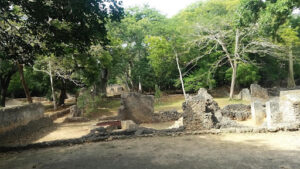
3. Kariandusi Prehistoric Site, Nakuru County
Kenya is often referred to as the “cradle of mankind,” and sites like Kariandusi are central to that claim.
Discovered by Louis Leakey in 1928, the Kariandusi Prehistoric Site is part of the Kenya Lake System in the Great Rift Valley, which has yielded many archaeological and paleontological discoveries.
Kariandusi is notable for its hand axes and other stone tools believed to be over 1 million years old, providing crucial evidence of early human activity in the region. The site includes a small museum and nature trail that enhance the visitor experience.
4. Hyrax Hill Prehistoric Site, Nakuru
Another gem in Kenya’s prehistoric crown, Hyrax Hill is an archaeological site dating back to between 1500 BCE and 500 BCE. It was also excavated by the Leakey family and reveals evidence of Neolithic settlements.
Hyrax Hill includes burial mounds, stone tools, pottery shards, and structures used for habitation.
The site has a small museum managed by the National Museums of Kenya that details the lifestyle and culture of the early communities in the area.
You may also look out into our;
- 2 Days Lake Nakuru Safari Package Tour
- 3 Days Nakuru Birdwatching Tour
- 4 Days Nakuru Naivasha Holiday Safari
- 6 Days Kenya Safari Tour Package
5. Lamu Old Town, Lamu County
Have you heard of Lamu Old Town? Located on Lamu Island, is Kenya’s oldest continuously inhabited town famously known as Lamu Old Town, and is another UNESCO World Heritage Site.
Established originating from the 14th century, it is one of the best-preserved examples of Swahili settlements in East Africa.
The town’s architecture is influenced by Swahili, Arabic, Persian, Indian, and European designs. With narrow winding streets, coral stone houses with intricately carved wooden doors, and numerous mosques, Lamu offers an authentic experience of Swahili heritage.
The Lamu Museum and cultural festivals like the Lamu Cultural Festival and Maulidi Festival attract both local and international visitors.
Check out also our;
which you can also seek to venture while exploring Lamu County.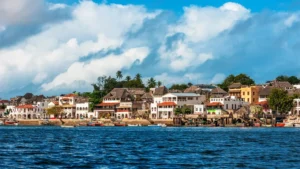
6. Nairobi Railway Museum
The railway played a pivotal role in shaping modern Kenya, especially during the colonial era. The Nairobi Railway Museum offers a deep dive into the story of the Uganda Railway (later Kenya-Uganda Railway), which was a major infrastructure project initiated by the British in the early 20th century.
The museum features steam locomotives, carriages, and personal items of early railway workers.
It also tells the story of the so-called “Lunatic Express” and the infamous man-eating lions of Tsavo, which killed dozens of railway workers in 1898.
7. Karen Blixen Museum, Nairobi
Located at the foot of the Ngong Hills, the Karen Blixen Museum is the former home of Danish author Karen Blixen, who wrote Out of Africa, a memoir that immortalized colonial life in Kenya.
The house was built in 1912 and still contains furniture and artifacts from the early 20th century.
The museum offers insights into colonial history, settler life, and the literary legacy of one of Kenya’s most famous foreign residents.
Check out our packages within Nairobi and nearby, such as;
- Full Day Nairobi City Tour
- Half Day Nairobi Tour Package
- Ultimate Ngong Hills Package
- Full Day Cocktail Package – Sip, Unwind & Explore
- 1 Day Kibera Slum Tour Nairobi
- Sky Cycling 1 Day Package
8. Kapenguria Museum, West Pokot
The Kapenguria Museum is located in the same prison where Kenya’s founding father, Jomo Kenyatta, and five other leaders collectively known as the “Kapenguria Six” were imprisoned by the British colonial government during the Mau Mau uprising.
The museum houses exhibits on the struggle for independence, Mau Mau resistance, and traditional Pokot culture. It is a powerful reminder of Kenya’s long and arduous path to self-determination.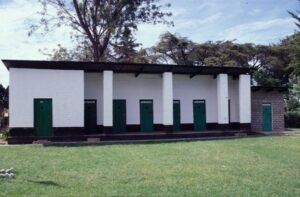
9. Jumba la Mtwana, Mtwapa
“Jumba la Mtwana,” meaning “House of the Slave” in Swahili, is a coastal ruin dating back to the 14th century. Located just north of Mombasa in Mtwapa, this site includes several stone buildings, mosques, and tombs, suggesting a once-bustling settlement.
The site is believed to have been a center of Swahili trade, potentially involved in the slave trade, though the evidence is limited.
Surrounded by lush vegetation and overlooking the ocean, it is both haunting and beautiful, evoking a powerful sense of historical mystery.
10. Uhuru Gardens, Nairobi
Uhuru Gardens National Monument and Museum is the site where Kenya officially gained independence from British rule on December 12, 1963.
It houses the famous independence monument, with a towering statue of two clasped hands holding a dove symbolizing peace.
The gardens serve as a national remembrance ground and are used for significant public celebrations and national holidays, making it one of the important historical sites in Nairobi Kenya.
12. Vasco Da Gamma Pillar, Kilifi County
The Vasco Da Gama Pillar in Malindi, Kilifi County, came to be due to a Portuguese explorer by the name of Vasco da Gama. He and his crew were sent by the back then King of Portugal, Don Manuel, to search for a sea route to India from Portugal.
The only way possible was to descend along the coastline of Africa and then go up to reach India. Their first stop was at Cape Town of Good Hope in South Africa. In 1498, it was when Vasco da Gama and his team reached Malindi, and they were warmly welcomed by the then Sultan of Malindi.
During that period, is when now the pillar was built as a navigator and a marker for future Portuguese sailors, making it one of the historical landmarks in Kenya left by the European people.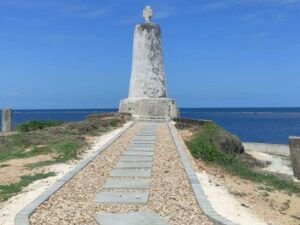
13. Kenyatta Mausoleum and Parliament Buildings, Nairobi
Located in the heart of Nairobi, the Kenyatta Mausoleum is the final resting place of Jomo Kenyatta. Nearby are the Parliament Buildings, where Kenya’s laws are debated and enacted.
While access to the mausoleum itself is restricted, the area remains an important site for understanding Kenya’s post-independence political development, making it one of the historical sites in Nairobi Kenya.
14. Thimlich Ohinga, Migori County
Lesser-known but equally important is Thimlich Ohinga, a UNESCO World Heritage Site in western Kenya. It is a complex of dry-stone-walled enclosures that date back over 500 years, built by the Luo people or related Nilotic communities.
These structures served as defensive settlements and social organization units. Thimlich Ohinga stands out as one of the best-preserved examples of early stone architecture in sub-Saharan Africa outside of Great Zimbabwe.
You may also check out some of our western Kenya packages, such as;
- 3 Days Western Kenya Cultural Tour Package
- 4 Days Western Kenya Wildlife Safari
- 4 Days Kakamega Forest National Reserve Package
Conclusion
Historical landmarks in Kenya are not just sites of ancient stone and weathered walls; they are vibrant testimonials to the country’s long journey through time.
From prehistoric sites in Kenya entailing human activity and ancient coastal trade cities, to colonial fortresses and freedom monuments, Kenya’s past is intricately woven into its present identity.
Whether you are a history enthusiast, a student of archaeology, or a traveler seeking a deeper understanding of Africa, historical places in Kenya offer a unique and enriching experience.
Exploring these historical sites in Kenya and their location, such as historical sites in Nairobi Kenya, is not merely a history lesson; it is a journey through the soul of a nation.
To be able to book a tour to any of the historical places in Kenya, consider Naicef as your historic tour guide and enquire via our contact, email at my@naicef.com, or call: +254799922277.
Always remember that Naicef is the leading tour company in Kenya, and also considered the best travel blog in Kenya and Africa at large, giving you luxurious experiences via our tour packages.
Frequently Asked Questions (FAQs) About Historical Places In Kenya
1. What are some of the famous historical places in Kenya?
They do include Fort Jesus Museum, Vasco Da Gama Pillar, Kapenguria Museum, Lamu Old Town, and Karen Blixen among others.
2. Are there prehistoric sites in Kenya?
Of Course, some of these prehistoric places found in Kenya are such as Hyrax Hill, Olorgesailie, and the famous Koobi Fora, whereby is renowned as the Cradle of Mankind.
3. Are there historic places that relate to Kenya’s struggle for independence?
Yes, there are. They do include the Kapenguria Museum, the Dedan Kimathi’s Statue, and the Jomo Kenyatta Masouleum among others.
4. What is so special about Lamu Old Town, isn’t it a town like just any other?
Lamu Old Town is so famous since its inhabitation has remained intact from its structural design of houses and street pavements since the early 14th century.
5. What is there to learn about the Nairobi Railway Museum?
The museum entails the history of the colonial period, when the railway construction was taking place, and even of the sad story about the Man-eaters of Tsavo.
